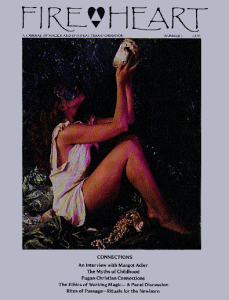 THE EIGHTFOLD PATH
THE EIGHTFOLD PATH
Part Four: BREATH
by Walter Wright Arthen ©1990
Breath is everywhere a synonym for “self,” a vehicle for the elan vital. T. H. Gaster
We live at the bottom of an ocean of air. Children’s Song
Breath … so natural, so easy. Yet breath is the most frequently over-looked of the steps on the Eightfold Path. Perhaps it is because breath is included in chanting and in many forms of meditation, or perhaps it is because breath is so ubiquitous. But while whole chapters in the major books about the Craft are devoted to each of the seven other steps on the path, breath rarely even gets mentioned, except as part of something else. Why is this? What, after all, is breath?
To be alive is to breathe. Humans breathe; animals breathe; trees and plants breathe; even bacteria breathe. Respiration is a basic physiological event, one which, in fact, evolved as the solution to a profound ecological crisis. The Earth’s earliest bacterial life forms – both “bubblers,” who produced food by fermentation, and blue-green algaes, who used photosynthesis – created an unwanted, polluting gas as a by-product of their feeding activity. This gas was oxygen, and it was highly poisonous for early life forms. Indeed, as the oxygen content of the Earth’s early atmosphere increased, great masses of bacteria died, destroyed by their own wastes. But some mutant bacteria coped and survived. Some sank into the muddy bottom of the original oceans where they were protected from the deadly new gas. Still others learned how to use the increasingly abundant oxygen to break up their food and release its energy for use – the breathers were born.
For us, too, breath is food. In breathing, we extract from the air substances necessary for our biological life, and we return “waste” substances to the surrounding air. The air we inhale is roughly 78% nitrogen and 21% oxygen. The air we exhale is roughly 78% nitrogen, 16% oxygen and 4% carbon dioxide. This marginal change is enough to sustain the oxygenation of our blood and to return carbon dioxide into the air for plant life. Further, this exchange of substances connects us directly to the systematic nexus of energy transformations that is life on Earth. The Earth is surrounded by a (usually) invisible and (preferably) odorless cloud. This cloud is shared by all living things. In it, “we live, move and have our being” although we are usually completely unaware of its existence. Breathing, we are in constant interaction with this cloud. as are all other living creatures. This cloud is churned continually by solar radiation, winds, ocean evaporation, and precipitation, as well as by all breathing creatures. The air we inhale has been in Africa, in Europe, and in the polar regions. Its constituents have been in the leaves of the rainforest trees, in the chimneys of industrial facilities, and in the lungs of elephants. We literally share and exchange life with every creature on the planet through the mediation of this vast cloud. In breathing, we are linked together with all creatures of the Earth.
And one can go further. The Earth’s atmosphere does not end abruptly and absolutely; it attenuates with the weakening gravity field until it ceases to be detectable. In fact, the emptiest reaches of interstellar space contain atoms of nitrogen and oxygen. To be sure, they are found in concentrations that are infinitesimally small, but they are there. Thus, in breathing we literally go beyond the confines of one small planet in an insignificant corner of this unimaginable cosmos and actually connect with all that is.
As a process, breathing is instinctual. It just goes on. We need not choose to take the next breath, and we are rarely aware of breathing as it occurs. Our awareness and attention are usually directed to that stream of associations that constitutes ordinary “inner” life. We take respiration for granted as a reliable, mechanical process that will continue without our concern or attention. We also take it for granted that the air will be there when we need it.
Given this state of affairs, it is perhaps no wonder that breath is the most universal tool of inner journeying in the world. Every human spiritual tradition has a concrete set of techniques for working with breath. Pataniali’s Yoga Sutras refer to pranayama, or breath control, as one basic technique of yoga. Even beginning students of yoga learn an array of methods for modifying, deepening, or holding the breath. Sufi dhikr often uses rhythmic or controlled breathing as a method of invocation. Something of the kind is also found in Buddhism, the Christian contemplative way, and the Western occult tradition. The Craft, despite its tendency to overlook breath, also uses it. To begin with, we have an understanding of air as one of the basic elements, and we have specific ways of using air for inner work. Through the air element, breathing is linked to such things as mind, intellect, communication, sunrise, and springtime. These connections can be invoked and used specifically in work with breathing.
The first and simplest way of working with breath is to become aware of it. Air is light and consciousness. We can change our usual robotic state by becoming conscious of the movement of air in and out as we breathe. In esoteric tradition, air is said to contain subtle substances in addition to the hydrogen, oxygen, and carbon dioxide familiar to us. These subtle substances, if properly digested, are said to serve as food for the “subtle” bodies which exist or can be created in human beings, and breathing consciously is one way in which the “digestion” of these “active elements” can take place. There are many ways in which awareness of breath can be approached, but all of them share the common feature of not disturbing the natural process of breathing as we find it. Whether one counts breaths, follows the movement of the diaphragm, or observes how breathing patterns are connected with inner states of various kinds, one leaves the breathing cycle as it is. These “passive” techniques are not often taught within the Craft, but they certainly have some application to relaxation and inward journeying. The can be used as preparations for other work, but they can also – in and of themselves – be tools for transformation.
Another set of techniques introduce intentional changes into the pattern of breathing. Perhaps at the beginning of a circle we take several deep breaths, drawing in the fresh, healing energy of air while intentionally releasing attachments and holdings into the exhalations. Altering the breath in this way is intended to bring about a corresponding alteration in one’s inner state as a preparation for the work that lies ahead. The basic physiology of breathing – feeding one’s cells with oxygen and releasing waste material into the ambient air – serves as a metaphor for the changes we wish to invoke in the group. We intend to let go of holdings and stale thoughts and to draw in fresh air, creating a liminal space between one’s “profane” life with its cares and concerns and the “sacred” space of magical work. These simple techniques should not be underestimated. In The Spiral Dance, Starhawk describes the technique of connecting through breath:
. . . feel our breath as it meets in the center of the circle … as we breathe as one … breathing one breath … inhale … exhale … breathing one circle … breathing one living organism … (p. 43)
Exercises like these can make the difference between a circle in which energy flows smoothly and openly, and a circle with blockages and resistances that remain unaddressed.
There are even more radical ways to manipulate breath to invoke still other actions or changes in consciousness. Because, as Theodore Gaster, an early 20th century religious scholar, says, “breath is everywhere a synonym for ‘self’,” our breath is usually taken to have something of the essence of ourselves in it. So when we wish to put some part of our will or ourselves into an object, one way to do so is by using breath. This is, of course, conscious or intentional breathing and not simply our usual “mechanical” exhalation. In fact, Jesus is depicted in the Bible as using this technique in healing work. Witches are said to use the breath to “charge” a tool, charm, or amulet with the energy of air. In these ways, breathing is used to transfer a particular energy or intention from one place to another.
In the deeper work of self-transformation, alterations in breathing can have a large part. I will mention three areas by way of example, but without specific indications of how these practices are done, since the techniques involved need to be transmitted directly, person to person. Correctly coordinating breathing with physical activity can greatly increase organic efficiency, improve dexterity and speed, and help create significant inner changes. We learn something of this in sports, but much more is possible. One example is the “kiai” of Karate-Do. The sharp, vocalized exhalation combines with rapid focused movement to produce a block, punch or kick of much greater power than the practitioner could otherwise achieve. In circles, or other magical work, this principle can be applied to intensify our work.
Secondly, retention of breath, if one is properly prepared, can create intense increases of internal sensation, and produce important changes in consciousness. Taught by some Yogic and Sufi teachers, these techniques also have application in Craft contexts. For example, in preparing for meditation or trance work, correctly applied retention of breath can deepen one’s state with great rapidity. Further, in combination with fasting – of which it is metaphorically another form – breath retention can create deep alterations in consciousness.
Changing and controlling patterns of breathing is the simplest way (and one of the most potent) for invoking rapid changes in state. Beyond the deep breathing “attunement” one can employ specific patterns of breathing to induce calming and physical relaxation, to arouse one’s energy for focused effort, to produce anger, depression or some other state, or even to induce a trance. There are many varieties of this practice, but the first simple steps may be made by watching the correlation in one’s own experience between breathing and inner states. This is a deep study, which can yield many rewards. When one becomes aware of how breathing correlates with emotional states, alteration of breathing can help invoke the corresponding feelings and awareness. And there is much more beyond this.
Breath is a topic of great subtlety and depth. In the Pagan community we have almost everything to learn about it. But the essential elements are so simple. The air is everywhere. It connects all that lives. Breath is a food that nourishes spirit. We breathe automatically, but the process can be shaped by attention and will. In shaping our breathing, we create change, and these changes can be understood and used. Following the basic principles outlined here, all that we need is time to learn what breath can teach. Breath work can carry you as far as you are willing to go. To pursue it requires no preparation, no special materials, and no hidden mysteries. All that is needed is that right now, in this moment, you pay attention to your own rhythms … and be here.
WALTER WRIGHT ARTHEN is co-editor of FireHeart and a member of the Board of Directors of the EarthSpirit Community. He is a frequent contributor to FireHeart. His writing blends wide experience with many spiritual paths and a commitment to building bridges between the Pagan community and secular culture.
